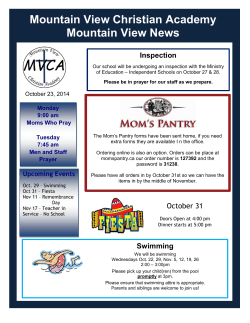
Swimming with CVCs and G Tubes yeah or nay?
Swimming with CVCs and G Tubes yeah or nay? Kathleen Gura PharmD, BCNSP, FASHP, FPPAG Boston Children’s Hospital SO, HOW CLEAN IS THAT WATER….. RecreaFonal Water-‐associated Outbreaks Centers for Disease Control and PrevenFon – Reported a total of 134 recreaFonal water-‐ associated outbreaks from 38 states and Puerto Rico in a two-‐year period – A total of 116 (86.6%) of the outbreaks were associated with treated recreaFonal water (e.g., swimming pools) RecreaFonal Water Illnesses (RWIs) ……..are caused by pathogens transmiXed by ingesFng, inhaling aerosols from, or having contact with contaminated water in swimming pools and other recreaFonal water venues. RWIs • wide variety of infecFons – gastrointesFnal, skin, ear, respiratory, eye, neurologic, and wound infecFons – most commonly reported RWI is diarrhea • Common organisms: – Cryptosporidium, Giardia, Shigella, norovirus and E. coli O157:H7 • Crypto has become the leading cause of swimming pool-‐related outbreaks of diarrheal illness – 2004 -‐ 2008, reported Crypto cases ↑ > 200% (from 3,411 cases in 2004 to 10,500 cases in 2008) – Can stay alive for days even in well-‐maintained pools CVL InfecFons & RecreaFonal Water Exposure: The Evidence Robbins (1999) – DescripFve study (self reported, parental quesFonnaire) – 91 pediatric oncology paFents (Children’s Hospital @ Strong) • 49 swimmers – 34 infecFons • 46 non swimmers – 13 infecFons – No significant difference in the rate of infecFon per catheter month; accounted for duraFon of catheter not on duraFon of exposure to recreaFonal water CVL InfecFons & RecreaFonal Water Exposure: The Evidence Smith (2002) • RetrospecFve case controlled study • Pediatric oncology paFents (Fresno Children’s) • PopulaFon • 25 cases with CRBSI • 25 cases with CVCs • No difference • However… • StaFsFcally significant increase in nonendogenous, gram negaFve infecFons in summer (May-‐October) • SummerFme recreaFonal water exposure high in both groups Swimming Pools Does Chlorine Do the Trick? • Most germs are killed by chloride (but not Crypto) – Crypto can remain alive up to 10 days in a well maintained chlorinated pool • Must keep chlorine at recommended levels is essenFal to maintain a healthy pool -‐ 2010 study: 1 in 8 public pool inspecFons resulted in pools being closed immediately due to serious code violaFons such as improper chlorine levels Fecal Coliform • Determines water quality in fresh, brackish and marine water environments • Florida Healthy Beaches Program Categories: – Good = 0-‐199 fecal coliform per 100 milliliters of marine water – Moderate = 200-‐399 fecal coliform per 100 milliliters of marine water – Poor = 400 or greater fecal coliform per 100 milliliters of marine water Florida Healthy Beaches Program: targeted organism categories • Good = 0-‐35 Enterococci per 100 milliliters of marine water • Moderate = 36-‐104 Enterococci per 100 milliliters of marine water • Poor = 105 or greater Enterococci per 100 milliliters of marine water SWIMMING WITH A CVL……. Email Survey of Pedi HPEN Programs (n= 16/27 program responded) 1) Do you allow your paFents with central venous catheters to go swimming? If yes, what bodies of water are allowed ocean, lake, pool ,etc.? 2) Are your paFents required to use dressings/coverings? If yes, which product(s)? 3) Are there any other rules that the paFents must follow? eleanorbrogan.blogspot.com Results • 3/16 (19%) only allowed their paFents with un-‐accessed ports that were well healed to go swimming • 5/16 (31 %) allowed paFents to go swimming with un-‐ accessed ports or tunneled catheters (Hickman®, Broviac®) • 2/16 (12.5%) allowed paFents to go swimming with cuffed peripherally inserted central catheters (i.e., PICCs) • 1/16 (6 %) allowed swimming without restricFons • 2/16 (12.5 %) allowed minimal swimming but did not specify a restricFon on the type of lines • 3/16 (19%) did not allow any swimming of any sort • 1/16 (6%) did not allow infants to go in the water but did allow older paFents to swim • 1/16(6%) had not had this quesFon/situaFon come up. For Programs that Allowed Swimming… • 2/16 (12.5%) allowed any body of water • 2/16 (12.5%) allowed oceans or pools • 1/16 (6 %) allowed oceans, pools, and private hot tubs • 6/16 (38 %) only allowed pools • 1/16 (6%) did not specify What others are doing…… hXp://oley.org/Swimming.html If you allowed swimming…. • Dressing or line covers varied among the programs • no consistency in the products recommended • Tegaderm® and AquaGuard® were both menFoned • All programs that allowed their paFents to go swimming recommended cleaning the site and changing the dressing immediately aoer swimming eleanorbrogan.blogspot.com PROTECTING YOUR LINE…. Press and Seal AquaGuard Dry Pro Dry Pro™ Waterproof Ostomy Protector AnchorDry Drysuit Swimming with G Tubes PEGS • At least wait 4-‐6 weeks aoer placement (when site it healed) • Make sure cap and/or clamp closed • Make sure the PEG tube is tucked into bathing suit (wear T-‐shirt, 1 piece suit) – Prevents pulling, geqng caught – Securely tape to abdomen with waterproof tape ProtecFng Yourself and Others Don't swim while ill with diarrhea – For paFents with cryptosporidiosis, don't swim for an addiFonal 2 weeks aoer diarrhea has resolved • Cryptosporidium conFnues to be shed aoer cessaFon of diarrhea • potenFal for intermiXent diarrhea might cause infected people to think symptoms have resolved, • increased transmission potenFal in chlorinated recreaFonal water venues because of the parasite's high chlorine tolerance Some Common Sense Guidelines • Don't swim when you have open wounds • Don't swallow the water • Keep ears as dry as possible and dry ears thoroughly aoer swimming – Use a bathing cap, ear plugs, or custom-‐fiXed swim molds – Ask about prophylacFc alcohol-‐based ear drops or a 1:1 mixture of rubbing alcohol and white vinegar Conclusions Thank You!
© Copyright 2025














